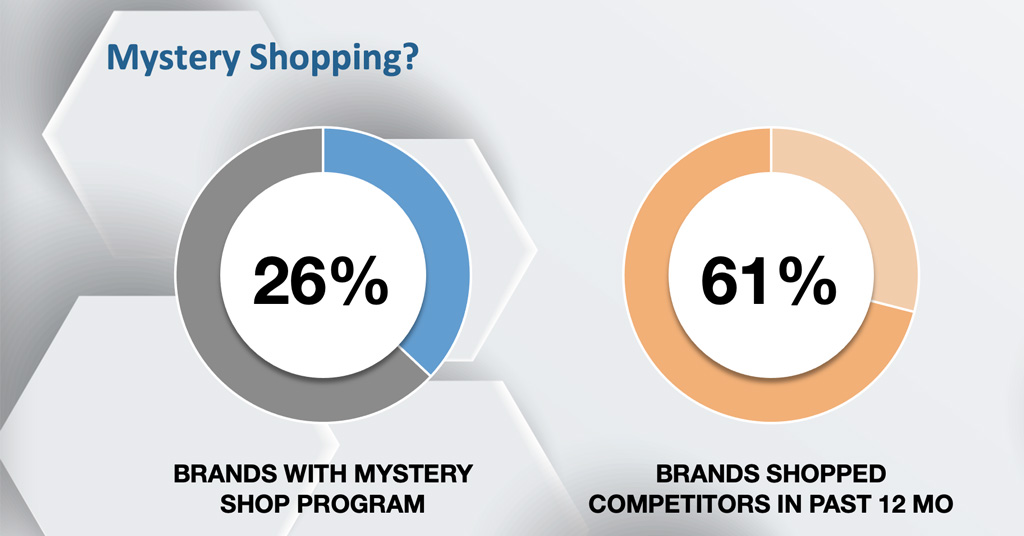3rd Annual Franchise Marketing Report, Part 8: Mystery Shopping – Franchising.com

This is the 8th installment in a series of highlights from the 2021 Annual Franchise Marketing Report (AFMR). Find part 1 here, part 2 here, part 3 here, part 4 here, part 5 here, part 6 here, and part 7 here.
2021 marked the release of the 3rd Annual Franchise Marketing Report (AFMR). This report provides franchise consumer marketers with invaluable data and analysis they can use to benchmark their performance against other franchise brands and within their industry sector. In short, the AFMR is a unique resource franchise marketers can use to improve the effectiveness of their marketing efforts and spend.
The ongoing pandemic, on top of franchising’s already competitive and frothy landscape, has strengthened the necessity for marketers to better understand how their brand measures up against the competition, as well as how it is performing in the wider marketplace. The AFMR can help franchise consumer marketers understand how their team compares with their peers and, more importantly, help them direct their limited resources into the most effective channels for achieving their system-wide goals during these uncertain times.
“This annual report was created at the request of our Franchise Marketing Leadership Conference Advisory Board to develop relevant content for CMOs, and to learn more about their needs and challenges,” said Diane Phibbs, executive vice president and chief content officer at Franchise Update Media.
Participants in the AFMR consisted of franchise marketing leaders who completed an in-depth questionnaire. Responses were aggregated and analyzed to produce a detailed look into the marketing practices, budgets, and strategies of a wide cross-section of franchise brands and sectors. The data and accompanying commentary and analysis provide the basis of the 2021 AFMR. Below is the 8th in a series of selected highlights from the new report.
Strike the iron while it’s hot, they say. But what if the iron (i.e., customers!) isn’t even there? With people isolated for much of the past 2 years, that’s essentially what happened to mystery shopping during Covid.
Only 26% of brands reported having a formal mystery shopping program this year, down from last year’s 32%. As Phibbs noted last October, “If your locations are closed or you can’t get to your consumers to deliver a service, then you don’t really need a mystery shopping program because there’s no one to shop.”
A mystery shopping program is an important tool for understanding how both franchised and company locations are performing. However, it has proven difficult to execute a mystery shopping program during the ongoing pandemic.
As the economy inches its way back toward pre-Covid levels, brands may want to consider adding mystery shopping and loyalty programs to ensure they are providing the best customer service possible. Understanding what consumers are looking for – and where they are looking for it – will be more critical than ever as the economy recovers.
Next time: Local Spend
Franchising.com is produced by Franchise Update Media. Franchise Update Media has its finger on the pulse of franchising with unrivalled audience intelligence and market driven data. No media company understands the franchise landscape deeper than Franchise Update Media.
P.O. Box 20547
San Jose, CA 95160
PH. (408) 402-5681
About | Advertise | Contact The franchise listed above are not related to or endorsed by Franchise Update or Franchise Update Media Group. We are not engaged in, supporting, or endorsing any specific franchise, business opportunity, company or individual. No statement in this site is to be construed as a recommendation. We encourage prospective franchise buyers to perform extensive due diligence when considering a franchise opportunity.
The franchise listed above are not related to or endorsed by Franchise Update or Franchise Update Media Group. We are not engaged in, supporting, or endorsing any specific franchise, business opportunity, company or individual. No statement in this site is to be construed as a recommendation. We encourage prospective franchise buyers to perform extensive due diligence when considering a franchise opportunity.
Copyright © 2001 – 2021. All Rights Reserved. Legal Notices | Privacy Policy



